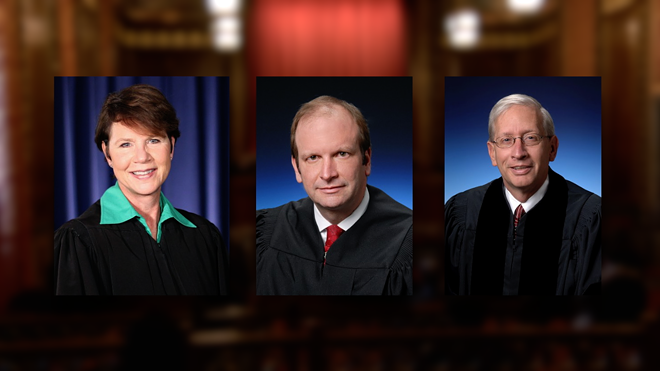
Republicans swept all three open seats on the Ohio Supreme Court Tuesday. The eventual Republican majority will have big implications in the state for years to come.
Associate Justice Sharon Kennedy, a Republican, beat Associate Justice Jennifer Brunner, a Democrat, in the race for chief justice.
Incumbent Justices Pat Fischer and Pat DeWine, both Republicans, also won over Democratic challengers Terri Jameson and Marilyn Zayas, respectively, according to unofficial results posted by the Secretary of State’s office.
Two other Democratic justices, Melody Stewart and Michael P. Donnelly, weren’t up for reelection. But with Gov. Mike DeWine — Justice DeWine’s father — poised to appoint an associate justice to replace Kennedy, the court is likely to have a 4-3 Republican majority.
And, while retiring Chief Justice Maureen O’Connor often played the role of a swing voter, Kennedy is expected to vote more consistently with the Republican majority.
“I’m extremely proud of the successful campaign we ran and thank the many Ohioans who put their trust in me to serve as Chief Justice,” Kennedy said in a statement late Tuesday. “I congratulate my opponent on a hard-fought campaign and look forward to continuing to work with her as colleagues on the Court. I’ve prepared my entire career to serve as Chief Justice and will be ready to lead on day one of my term.”
Pat DeWine said he’d continue to protect the rule of law.
“I’m thrilled with the support from so many Ohioans and thank the more than 1 million people who re-elected me to the Ohio Supreme Court,” he said. “Protecting the rule of law as a Supreme Court Justice has been the highlight of my legal career and I’m honored to continue doing it for another six years.”
This year’s Supreme Court elections have taken on perhaps their highest profile in state history.
One big reason is because the U.S. Supreme Court in June pushed the job of deciding the constitutionality of harsh abortion restrictions onto state supreme courts.
In Dobbs v Jackson Women’s Health, the conservative majority on the federal high court ruled that nothing in the U.S. Constitution prevents states from banning abortion outright. As it did so, the court ignored claims by the medical community that the procedure is often necessary to protect women’s health.
Now many state supreme courts — including Ohio’s — are being asked to decide whether strict limitations on abortion violate their states’ constitutions.
When Dobbs was handed down, it allowed enforcement of a 2019 state law that prohibits abortions after about five or six weeks of pregnancy. The law doesn’t make exceptions for rape and incest, and Ohio doctors say it’s protections for mother’ health are often vague and unworkable.
After reports of very young rape victims being forced to leave the state for abortions — along with mothers with serious health problems — Ohio abortion clinics sued. A Cincinnati judge in September temporarily blocked enforcement of the Ohio law, ruling that it violates the state Constitution.
But the state is appealing that ruling and the case is expected to make its way up to the Ohio Supreme Court, possibly early next year. Also possibly coming before the court would be any near-total abortion ban that might be passed in this year’s lame-duck session.
Republicans on the Supreme Court might already have hinted how they’ll rule in abortion cases.
Judicial candidates frequently tell the press that they can’t comment publicly on issues that are likely to come before them. But in October, News 5 Cleveland reported that Ohio’s Republican candidates — Pat DeWine, Fischer and Kennedy — told an anti-abortion group in questionnaires that they didn’t agree with a federal constitutional guarantee of abortion.
While the question they would have to decide is whether the state Constitution guarantees access to abortion, the Republicans’ responses could be telling.
Another important issue that’s likely to come before the court has already been before it and has been a major factor in Tuesday’s election — redistricting.
Pursuant to constitutional amendments passed by more than 70% of Ohio voters, the state is supposed to draw congressional and state legislative districts that don’t wildly overrepresent one party, as the Republicans are now. For example, the state has gone roughly 54% R and 46% D over the past decade, yet the GOP controls 76% of the seats in the Ohio Senate.
The constitutional amendments created a redistricting commission that was controlled by Republicans by a 5-2 margin.
That group submitted five sets of legislative maps that all were rejected by Chief Justice O’Connor, a Republican, and the three Democrats on the court. It also submitted two sets of congressional maps that were rejected.
The maps still were too favorable to Republicans, the majority ruled.
Justice DeWine voted in favor of the Republican maps even though some ethics experts said he should have recused himself because his father, Gov. DeWine, was a member of the redistricting commission.
In the end, time ran out and Ohio’s state lawmakers and congressional candidates all ran Tuesday in districts that are officially unconstitutional.
A frustrated Chief Justice O’Connor has said Ohio voters must pass a more ironclad ballot measure if they want to end extreme partisan gerrymandering in the Buckeye State.
Originally published by the Ohio Capital Journal. Republished here with permission.
